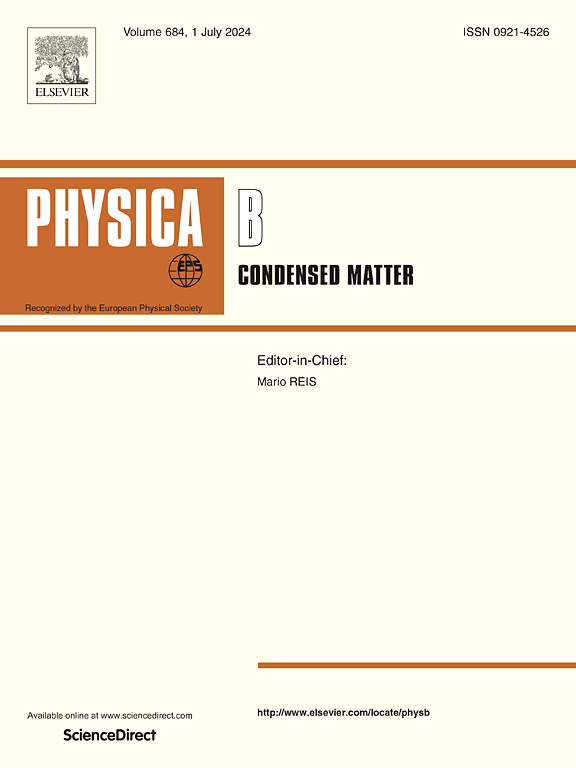Unraveling the role of plasma focus device power during deposition of copper oxide thin films: Structural and optoelectrical attributes
IF 2.8
3区 物理与天体物理
Q2 PHYSICS, CONDENSED MATTER
引用次数: 0
Abstract
This study introduces a novel approach by utilizing the Plasma Focus Device (PFD) for Cu2O thin-film deposition, offering a unique method to precisely control film properties. A systematic analysis of the structural, and optoelectrical characteristics across different applied discharge voltages aimed to establish connections between deposition parameters and film attributes. Experimental measurements utilizing instruments like the voltage divider, Rogowski coil current monitor, electron beam detector, and photomultiplier output recorded using a digital oscilloscope to assess plasma focus parameters. Copper oxide thin films were deposited on glass substrates using a plasma focus device, employing varied discharge power and an oxygen-helium gas mixture (50: 50 ratio) for deposition at 20 mTorr. Structural assessments employing X-ray diffraction (XRD) and scanning electron microscopy (SEM) unveiled voltage-induced alterations in crystallite size, orientation, and morphology, impacting the film's crystallinity and surface characteristics. Notably, increasing discharge power led to an enlargement of crystallite size from ≈14 nm to ≈18 nm. The direct energy band gap of the films was found to be decreased from 2.10 eV to 1.81 eV with an increase in the discharge power. In addition, the dielectric parameters were analyzed whereby it was found that the static refractive index n0 and lattice dielectric constant ε∞ reduce with increasing the discharge power. Moreover, a Faraday cup (FC) detector within a frequency range of 100 Hz to 5 MHz at room temperature was used to detect the ion beam energy and intensity measurements as well as the estimation of the electron beam energy at the side-on location from the plasma focus device under consideration. This work provides insights into optimizing Cu2O thin films for optoelectronic applications.
在氧化铜薄膜沉积过程中等离子聚焦器件功率的作用:结构和光电属性
本研究介绍了一种利用等离子体聚焦装置(PFD)沉积Cu2O薄膜的新方法,为精确控制薄膜性能提供了一种独特的方法。系统分析了不同外加放电电压下的结构和光电特性,旨在建立沉积参数与薄膜属性之间的联系。利用分压器、Rogowski线圈电流监测器、电子束探测器和光电倍增管输出等仪器进行实验测量,使用数字示波器记录等离子体聚焦参数。采用等离子体聚焦装置,采用不同的放电功率和50:50的氧氦混合气体,在20mtorr下沉积氧化铜薄膜。利用x射线衍射(XRD)和扫描电子显微镜(SEM)进行的结构评估揭示了电压引起的晶体尺寸、取向和形态的改变,影响了薄膜的结晶度和表面特性。值得注意的是,随着放电功率的增加,晶体尺寸从≈14 nm增大到≈18 nm。随着放电功率的增大,薄膜的直接能带隙从2.10 eV减小到1.81 eV。此外,对介质参数进行了分析,发现静态折射率n0和晶格介电常数ε∞随放电功率的增大而减小。此外,利用法拉第杯(FC)探测器,在100 Hz ~ 5 MHz的室温频率范围内,对等离子体聚焦装置的离子束能量和强度进行了检测,并对侧边位置的电子束能量进行了估计。这项工作为优化用于光电应用的Cu2O薄膜提供了见解。
本文章由计算机程序翻译,如有差异,请以英文原文为准。
求助全文
约1分钟内获得全文
求助全文
来源期刊

Physica B-condensed Matter
物理-物理:凝聚态物理
CiteScore
4.90
自引率
7.10%
发文量
703
审稿时长
44 days
期刊介绍:
Physica B: Condensed Matter comprises all condensed matter and material physics that involve theoretical, computational and experimental work.
Papers should contain further developments and a proper discussion on the physics of experimental or theoretical results in one of the following areas:
-Magnetism
-Materials physics
-Nanostructures and nanomaterials
-Optics and optical materials
-Quantum materials
-Semiconductors
-Strongly correlated systems
-Superconductivity
-Surfaces and interfaces
 求助内容:
求助内容: 应助结果提醒方式:
应助结果提醒方式:


